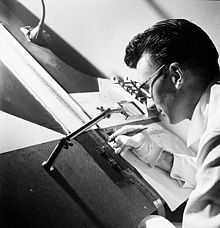Drawn-on-film animation: Difference between revisions
m Quick-adding category Drawn on film animation (using HotCat) |
|||
| Line 51: | Line 51: | ||
*[http://www.nfb.ca/animation/objanim/en/films/film.php?sort=director&director=Magalh%E3es%2C+Marcos&id=16804 Watch "Animando", which teaches how to use the technique (along with 9 others)] |
*[http://www.nfb.ca/animation/objanim/en/films/film.php?sort=director&director=Magalh%E3es%2C+Marcos&id=16804 Watch "Animando", which teaches how to use the technique (along with 9 others)] |
||
*[http://www.youtube.com/watch?v=cTFBirVC8Jg Watch Heide StrangeSky's short, ''Revolver'' an experimental Direct Animation; taking the technique a step further.] |
*[http://www.youtube.com/watch?v=cTFBirVC8Jg Watch Heide StrangeSky's short, ''Revolver'' an experimental Direct Animation; taking the technique a step further.] |
||
*[http://www.centerforvisualmusic.org/Library.html Many articles about direct animation at the CVM Library] |
|||
{{Animation}} |
{{Animation}} |
||
Revision as of 07:25, 4 July 2009
Drawn on film animation, also known as direct animation or animation without camera, is an animation technique where footage is produced by creating the images directly on film stock, as opposed to any other form of animation where the images or objects are photographed frame by frame with an animation camera.
Techniques

There are two basic methods to produce animation directly on film. One starts with blank film stock, the other one with black (already developed) film. On blank film the artist can draw, paint, stamp, or even glue objects. Black film (or any footage) can be scratched, etched, sanded, or punched. Any tool the artist finds useful may be used for this, and all techniques can be combined endlessly. The frame borders may be observed or completely ignored, found footage may be included, any existing image might be distorted by mechanical or chemical means.
35mm film is preferred, but direct animation is done on 16 mm or even Super 8 mm film as well. Because of the tedious technique most films of this kind are quite short. Many films of this kind feature a prominent soundtrack, and a lot of those are made exactly in sync with music. Since the sound strip on 35 mm film is optical, it is possible to create synthetic sound as well as images.
The first and best known practictioners of drawn on film animation were Len Lye, Norman McLaren, Stan Brakhage and Steven Woloshen who produced numerous animated films using these methods. Their work already covered the whole span between storytelling and totally abstract animation. Other filmmakers in the 1960s expanded the idea and treated the film stock more and more radical towards destruction, up to the point where a film was treated beyond any possibility to survive projection. Some artists made this destruction a statement, others went back one step and copied the original work film strip to get a projection copy.
Direct animation is a very cheap way to produce a film, it can be done on film strips right out of the garbage bin. This might explain its popularity among film students world-wide. Norman McLaren wrote a short illustrated introduction "How to make animated movies without a camera" which was originally published by UNESCO in 1949.
Animators and films
- In 1912, Italian Futurists Arnaldo Ginna and Bruno Corra discuss their nine abstract films (now lost) in their text Abstract Cinema - Chromatic Music.
- In 1916, American concert pianist Mary Hallock-Greenewalt produced hand-painted films for projection in her visual music player the Sarabet.
- In 1926 Man Ray created Emak Bakia, which includes sequences made by exposing film directly to light.
- In 1935 Len Lye created the first direct film screened to a general audience, a promotion for the British General Post Office entitled A Colour Box. Lye and Norman McLaren produced hand-painted films for John Grierson in the GPO Film Unit. Lye went on to create direct films in New York.
- Beginning in 1941, McLaren continued this work at the National Film Board of Canada (NFB), founding the NFB's animation unit. NFB direct films created or co-created by McLaren include Boogie-Doodle (1941),[1] Hen Hop (1942)[2] and Begone Dull Care (1949).
- In 1946, Harry Smith produced hand-painted films in San Francisco which screened at the Art in Cinema series at the San Francisco Museum of Art.
- In 1970, José Antonio Sistiaga exhibited the first feature-length hand-painted film, the silent epic ... era erera baleibu izik subua aruaren ..., in Madrid.
- Stan Brakhage, Mothlight (1963)
- Harry Everett Smith, Artist Profil, Filmography, Bibliography
- Pierre Hébert, Memories of War (1982)
- Cathy Joritz, Negative Man (2 min, 1985)
- Cathy Joritz, "Give AIDS the Freeze" (1 min)
- Bärbel Neubauer
- Richard Reeves
- Jürgen Reble / Schmelzdahin
- Wes Southern[3]
- Heide StrangeSky, "Revolver" (2002, 8 min)
- Steven Woloshen produced and directed Ditty Dot Comma (2001, 3 min). The first hand-painted film in the CinemaScope format.
Bibliography
- Robert Russett, Cecile Starr: Experimental Animation: Origins of a New Art (1988), ISBN 0-306-80314-3
- Malcolm LeGrice, Abstract Film and Beyond. [MIT Press, 1979]
- The Dream of Color Music, And Machines That Made it Possible
- Michael Betancourt, Mary Hallock-Greenewalt: The Complete Patents. [Wildside Press, 2005]
References
- ^ McLaren, Norman (1941). "Boogie-Doodle". NFB.ca. National Film Board of Canada. Retrieved 2009-04-09.
- ^ McLaren, Norman (1942). "Hen Hop". NFB.ca. National Film Board of Canada. Retrieved 2009-04-09.
- ^ Video - "Untitled 1" 1998
External links
- Drawing on film explained at the National Film Board of Canada
- An article about contemporary american filmmakers in this field
- Article about several experimental filmmakers and their techniques
- Watch Caroline Leaf's Two Sisters, an award-winning animated short film which uses the technique
- Watch "Animando", which teaches how to use the technique (along with 9 others)
- Watch Heide StrangeSky's short, Revolver an experimental Direct Animation; taking the technique a step further.
- Many articles about direct animation at the CVM Library
